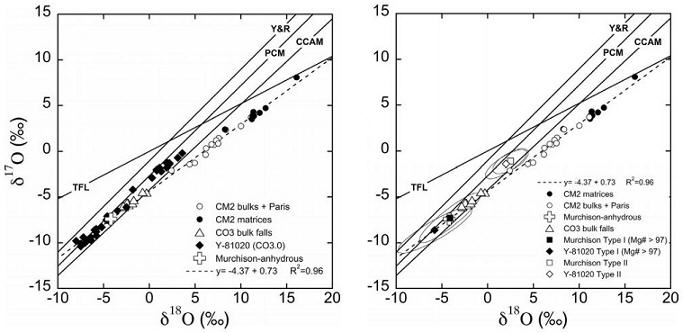Collisional Disruption of a Primary Planetary Body
Collisional Disruption of a Primary Planetary Body

On one scale of Solar SystemThe Sun and set of objects orbiting around it including planets and their moons and rings, asteroids, comets, and meteoroids. history, the nascence of planetesimal formation spanned less than 100 m.y. The most active period was determined to be the first 10–20 m.y., just after Jupiter and Saturn had formed and the protoplanetary diskFlattened and rotating disk of dense gas and dust/solids orbiting a young star from which planets can eventually form. Click on Term to Read More was voidHuge region of space that is unusually empty of galaxies. Voids are not entirely empty, but are underdense and contain far fewer bright galaxies than average. of its gas shroud (Davison et al., 2013). During this time a dynamical, random, collisional evolution played out–collisional growth proceeded in the face of ongoing disruptive impact events on contemporaneous accreting bodies. A number of these growing planetesimalsHypothetical solid celestial body that accumulated during the last stages of accretion. These bodies, from ~1-100 km in size, formed in the early solar system by accretion of dust (rock) and ice (if present) in the central plane of the solar nebula. Most planetesimals accreted to planets, but many – Click on Term to Read More accumulated heat through energetic impacts and the decay of radiogenic elements such as 26Al, beginning a stage of gravitational differentiationA process by which a generally homogeneous chondritic body containing mostly metal, silicates and sulfides will melt and form distinct (differentiated) layers of different densities. When the melting process continues for a long enough period of time, the once chondritic body will re-partition into layers of different composition including Click on Term to Read More into a crustOutermost layer of a differentiated planet, asteroid or moon, usually consisting of silicate rock and extending no more than 10s of km from the surface. The term is also applied to icy bodies, in which case it is composed of ices, frozen gases, and accumulated meteoritic material. On Earth, the Click on Term to Read More, silicateThe most abundant group of minerals in Earth's crust, the structure of silicates are dominated by the silica tetrahedron, SiO44-, with metal ions occurring between tetrahedra). The mesodesmic bonds of the silicon tetrahedron allow extensive polymerization and silicates are classified according to the amount of linking that occurs between the mantleMain silicate-rich zone within a planet between the crust and metallic core. The mantle accounts for 82% of Earth's volume and is composed of silicate minerals rich in Mg. The temperature of the mantle can be as high as 3,700 °C. Heat generated in the core causes convection currents in Click on Term to Read More, and metallic coreIn the context of planetary formation, the core is the central region of a large differentiated asteroid, planet or moon and made up of denser materials than the surrounding mantle and crust. For example, the cores of the Earth, the terrestrial planets and differentiated asteroids are rich in metallic iron-nickel. Click on Term to Read More. Some of the larger planetesimals developed a rotating core dynamo producing a weak magnetic field, as evidenced by the paleomagnetic signature detectable today in their associated meteorites.
Davison et al. (2013) calculated that during the first 100 m.y. only a very few planetesimals (<~50) were able to grow to very large sizes, in the range of 200–600 km in diameter, without experiencing a disruptive collision. At the same time, there is meteoritical evidence that suggests a few planetesimals grew to protoplanetary (or even planetary) sizes before experiencing a disruptive collision; i.e., an impact by an object typically >~60 km in diameter traveling ~18–25 km/s. As an example, it was proposed by Irving et al. (2009) that the diverse meteoriteWork in progress. A solid natural object reaching a planet’s surface from interplanetary space. Solid portion of a meteoroid that survives its fall to Earth, or some other body. Meteorites are classified as stony meteorites, iron meteorites, and stony-iron meteorites. These groups are further divided according to their mineralogy and Click on Term to Read More lithologies with similar O-isotopic compositions to the HED clan of meteorites, generally considered to be derived from the asteroid 4 VestaThird largest and fourth brightest asteroid; it was discovered in 1807 by Heinrich Olbers and named for the ancient Roman goddess of the hearth. 4 Vesta has a basaltic surface composition and an average density not much less than that of Mars. Evidently lava once flowed here indicating that the, were once part of an even larger former differentiated planetary body which they named “Opis” (the mother of Vesta in Greek mythology).
Another such hypothesized collisionally-disaggregated planetary body (here named “Antaeus“) was conceived by Irving et al. (2004) to have comprised many diverse lithologies, here expanded upon to include the following: a metallic core region composed of IIF-type iron like Del Rio (Kracher et al., 1980), IVB-type iron like Santa Clara and/or South Byron trio-type iron (Corrigan et al., 2017; Hilton et al., 2018); a core–mantle boundary or upper mantle impact-melted zone composed of a metal+silicate assemblage that corresponds to the Milton pallasiteOne of two main classes of stony-iron meteorite, the other being mesosiderites. Pallasites are igneous in nature and characterized by crystals of olivine, sometimes peridot (green gem quality clear olivine crystals), embedded in a matrix of Fe-Ni metal. The type specimen, weighing 680 kg, was found in the mountains near Click on Term to Read More (Sanborn et al., 2018), along with the NWA 176 (related to Bocaiuva; Liu, 2001) silicated iron; a dunitic mantle zone possibly represented by NWA 7822; an intensely thermally-metamorphosed stratigraphy resembling the NWA 3133 and NWA 10503 metachondrites (Irving et al., 2004; Irving et al., 2016; Sanborn et al., 2018); and a thick insulating crust (~20 km; Davison et al., 2013), possibly involving a late accretionary stage, comprising a primitive chondrule–CAI-rich regolithMixture of unconsolidated rocky fragments, soil, dust and other fine granular particles blanketing the surface of a body lacking an atmosphere. Regolith is the product of "gardening" by repeated meteorite impacts, and thermal processes (such as repeated heating and cooling cycles). Click on Term to Read More consisting of several distinct lithological zones comprising reduced Allende-like, oxidized Allende-like, and highly aqueously-altered Bali-like material. The detailed petrogenetic sequences by which each of these meteorites acquired their present form, and the question as to whether these events occurred before, during, or after a catastrophic disruption of the primary planetary body (or were associated with post-disruption daughter objects), are subjects that are still under investigation.
Importantly, the O- and Cr-isotopic signatures of Eagle Station have been utilized to establish an early formation age of 4.557 b.y., or 11 m.y. years after CAISub-millimeter to centimeter-sized amorphous objects found typically in carbonaceous chondrites and ranging in color from white to greyish white and even light pink. CAIs have occasionally been found in ordinary chondrites, such as the L3.00 chondrite, NWA 8276 (Sara Russell, 2016). CAIs are also known as refractory inclusions since they Click on Term to Read More formation. According to Dauphas et al. (2005), application of the Hf–W isotopic chronometer to Eagle Station also gives a relatively late metal–silicate segregation for Eagle Station of ~10 m.y. after differentiation of the HED parent bodyThe body from which a meteorite or meteoroid was derived prior to its ejection. Some parent bodies were destroyed early in the formation of our Solar System, while others like the asteroid 4-Vesta and Mars are still observable today. Click on Term to Read More 4 Vesta (which occurred as early as 1.3 m.y. after CAI formation; Schiller et al., 2010). Since it has been calculated that melting and core–mantle differentiation due to radiogenic heating should cease after ~7–8 m.y. (Sahijpal et al., 2007), it may be inferred that heating of the Eagle Station asteroid continued until after all radiogenic 26Al and 60Fe was extinct, and that such late heating would have been generated through large impact events. In support of that reasoning, John T. Wasson (2016) presented evidence that the slow heating generated entirely by the decay of 26Al is insufficient to melt asteroids, and that an additional heat source would have been required; e.g., the rapid heating incurred from major impact events. He determined that the canonical 26Al/27Al ratio of 0.000052 is much too low to cause any significant melting, and that a minimum ratio of 0.00001 would be required to produce a 20% melt fraction on a well-insulated body having a significant concentration of 26Al. For example, the initial ratio of 0.0000004–0.0000005 calculated for the angrites Sah 99555 and D’Orbigny based on their 26Al–26Mg isochrons is too low to have generated any significant melting without an additional heat source. Therefore, impacts were a major source of heating in early solar systemDefinable part of the universe that can be open, closed, or isolated. An open system exchanges both matter and energy with its surroundings. A closed system can only exchange energy with its surroundings; it has walls through which heat can pass. An isolated system cannot exchange energy or matter with history.
Likewise, the formation scenario envisioned for the silicated irons NWA 176 and Bocaiuva is consistent with impact-heating events on a small-sized asteroid. The final mixing event was accompanied by an initial rapid-cooling stage beginning at the metal–silicate equilibriumTerm used to describe physical or chemical stasis. Physical equilibrium may be divided into two types: static and dynamic. Static equilibrium occurs when the components of forces and torques acting in one direction are balanced by components of forces and torques acting in the opposite direction. A system in static Click on Term to Read More temperature of ~1100 °C, and was sustained down to ~600 °C. This was followed by a slow cooling stage in which a Thomson (Widmanstätten) structure was formed (Desnoyers et al., 1985). Another fast cooling stage was initiated between approximately 600 °C and 300 °C as indicated by the absence of tetrataenite and other petrographic features (Araujo et al., 1983). There are major structural similarities between the NWA 176 and Bocaiuva silicated irons and those silicated iron members of the IIE and IAB complex iron groups. This suggests that similar impact processes, such as a catastrophic breakup event, occurred on each of these relatively small, nonmagmatic parent bodies; however, only the IIF irons and the Eagle Station pallasites share any significant geochemical similarities with NWA 176 and Bocaiuva (Bunch et al., 1970; Curvello et al., 1983). Notably, NWA 176, Bocaiuva, and the Eagle Station pallasites, as well as other distinct meteorite lithologies, have similar O- and/or Cr-isotopic compositions to the CV chondritesMeteorite class named after the Vigarano meteorite that fell in Italy in 1910. They have abundant large, well-defined rimless (?) chondrules of magnesium-rich olivine (~0.7 mm diameter; 40-65 vol. %), often surrounded by iron sulfide. They also contain 7-20 vol. % CAIs. The often dark-gray matrix is dominated by Fe-rich Click on Term to Read More (Clayton and Mayeda., 1996; Liu et al, 2001; Shukolyukov and Lugmair, 2001). Taking the many similarities into account, it seems possible that these otherwise disparate meteorites originated on a common chondritic precursor parent body (Malvin et al., 1985).
In an effort to better resolve potential genetic relationships that might exist among the meteorites mentioned above associated with the hypothetical Antaeus, a Cr-isotopic analysis of olivineGroup of silicate minerals, (Mg,Fe)2SiO4, with the compositional endpoints of forsterite (Mg2SiO4) and fayalite (Fe2SiO4). Olivine is commonly found in all chondrites within both the matrix and chondrules, achondrites including most primitive achondrites and some evolved achondrites, in pallasites as large yellow-green crystals (brown when terrestrialized), in the silicate portion Click on Term to Read More from the Milton pallasite was conducted by Sanborn et al. (2018). It is demonstrated on a coupled Δ17O vs. ε54Cr diagram (shown below) that Milton plots among the CV clan and plausibly shares a genetic relationship, but also that Eagle Station plots closer to the CK (or CO) chondriteChondrites are the most common meteorites accounting for ~84% of falls. Chondrites are comprised mostly of Fe- and Mg-bearing silicate minerals (found in both chondrules and fine grained matrix), reduced Fe/Ni metal (found in various states like large blebs, small grains and/or even chondrule rims), and various refractory inclusions (such Click on Term to Read More group. It could be inferred that both the CV and CK planetesimals experienced a similar petrogenetic history in a similar isotopic reservoir of the nascent solar system.
Chromium vs. OxygenElement that makes up 20.95 vol. % of the Earth's atmosphere at ground level, 89 wt. % of seawater and 46.6 wt. % (94 vol. %) of Earth's crust. It appears to be the third most abundant element in the universe (after H and He), but has an abundance only Click on Term to Read More IsotopeOne of two or more atoms with the same atomic number (Z), but different mass (A). For example, hydrogen has three isotopes: 1H, 2H (deuterium), and 3H (tritium). Different isotopes of a given element have different numbers of neutrons in the nucleus. Click on Term to Read More Plot
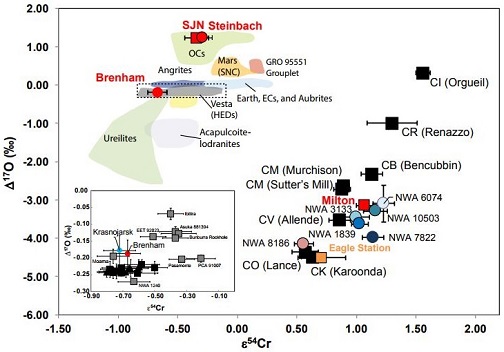
click on diagram for a magnified view
Diagram credit: Sanborn et al., 49th LPSC, #1780 (2018)
Notably, a formation scenario for pallasites was proposed by Asphaug et al. (2006) and Danielson et al. (2009) in which the wide variation in metal–silicate textures and bulk compositions that is observed among MG pallasite members is the result of a grazing collision between partially molten planetary embryos. They assert that such a collision resulted in the formation of a chain of smaller objects having diverse compositions. It may be more than coincidental that the O-isotopic composition of the Milton pallasite plots proximate to the trend line of the Eagle Station group pallasites (now termed the Allende Mixing line: slope = 0.94 ±0.01). Both of these rapidly-cooled pallasites contain high concentrations of the refractory siderophile elementLiterally, "iron-loving" element that tends to be concentrated in Fe-Ni metal rather than in silicate; these are Fe, Co, Ni, Mo, Re, Au, and PGE. These elements are relatively common in undifferentiated meteorites, and, in differentiated asteroids and planets, are found in the metal-rich cores and, consequently, extremely rare on Ir relative to main-group (MG) pallasites (Jones et al., 2003), and they both have overlapping Fe and Ni abundances (wt%) in their metalElement that readily forms cations and has metallic bonds; sometimes said to be similar to a cation in a cloud of electrons. The metals are one of the three groups of elements as distinguished by their ionization and bonding properties, along with the metalloids and nonmetals. A diagonal line drawn Click on Term to Read More component; however, significant variations observed in their minor and trace elementSubstance composed of atoms, each of which has the same atomic number (Z) and chemical properties. The chemical properties of an element are determined by the arrangement of the electrons in the various shells (specified by their quantum number) that surround the nucleus. In a neutral atom, the number of Click on Term to Read More concentrations indicate that they each experienced different crystallizationPhysical or chemical process or action that results in the formation of regularly-shaped, -sized, and -patterned solid forms known as crystals. Click on Term to Read More processes (Hillebrand, 2004). Still, there is a good possibility that one or both of these pallasites did share a common precursor parent body with the CV clan of meteorites, at least prior to any collisional disruption event.
Diagram adapted from Korochantsev et al., 44th LPSC, #2020 (2013)
With the advent of better investigative techniques, scientists have explored the possibility of a genetic relationship between IVB irons and other meteorite groups based on O-isotopic analyses. Utilizing chromiteBrownish-black oxide of chromium and iron (Cr-Fe oxide), Cr2FeO4, found in many meteorite groups. Click on Term to Read More grains from IVB irons Warburton Range and Hoba, Corrigan et al. (2017) found that IVB irons share close similarities to the South Byron trio irons (Babb’s Mill [Troost’s], South Byron, and Inland Forts [ILD] 83500)–Milton pallasite grouping (MSB in diagram below). Moreover, the O-isotopic compositions of the IVB irons and the South Byron trio–Milton grouping fallMeteorite seen to fall. Such meteorites are usually collected soon after falling and are not affected by terrestrial weathering (Weathering = 0). Beginning in 2014 (date needs confirmation), the NomComm adopted the use of the terms "probable fall" and "confirmed fall" to provide better insight into the meteorite's history. If Click on Term to Read More within the range of the oxidizedOxidation and reduction together are called redox (reduction and oxidation) and generally characterized by the transfer of electrons between chemical species, like molecules, atoms or ions, where one species undergoes oxidation, a loss of electrons, while another species undergoes reduction, a gain of electrons. This transfer of electrons between reactants Click on Term to Read More CV and CK chondritesChondrites are the most common meteorites accounting for ~84% of falls. Chondrites are comprised mostly of Fe- and Mg-bearing silicate minerals (found in both chondrules and fine grained matrix), reduced Fe/Ni metal (found in various states like large blebs, small grains and/or even chondrule rims), and various refractory inclusions (such Click on Term to Read More.

Diagram credit: Corrigan et al., 48h LPSC, #2556 (2017)
Subsequent to the catastrophic disruption of the primary planetary body that is envisioned here, and the sorting and re-accretion of material into a number of daughter objects, multiple impacts onto these small asteroids could have led to the formation of sub-surface melt pools tens of meters in size. Differentiation of these melt pools would have resulted in cumulus olivine sequestered above a metal layer, and an olivine residuum that had drained below this metal layer–a complex assemblage from which associated pallasitic and silicated-iron lithologies could be derived thereafter during less-energetic, rapidly-cooled impact events (Malvin et al., 1985). The anomalously-high Ir contents measured in some of the associated metal–silicate mixtures (e.g., Eagle Station group, Milton) and segregated metal regions (IIF irons, South Byron trio) would be consistent with metal that crystallized at the lowest levels of the melt chamber. Such late-stage, rapidly-cooled, impact-heating events could have allowed for the retention of the original O- and Cr-isotopic composition of the primary planetary body (Humayun and Weiss, 2011 and references therein). The differences that exist in δ54Cr between chromite and olivine in the Eagle Station pallasite, but which are not observed in CV chondrites, could be the result of a distinct Cr source associated with impact projectile(s) which eventually led to the formation of the Eagle Station-type pallasites and other related lithologies (Papanastassiou and Chen, 2011).
On an oxygen three-isotope diagram (see example below), the CO chondrites plot along the Allende Mixing trend line (former CCAM line), overlapping near the middle of the CV chondrite field. There is a possibility that the CO chondriteMeteorite class named after the Ornans meteorite that fell in France in 1868, are related in chemistry and composition to the CV chondrites and may, with them, represent a distinct clan of carbonaceous chondrites that formed in the same region of the early solar system. However, COs are usually blacker Click on Term to Read More group, of which Isna is a highly metamorphosed example (type 3.75), is also implicated in the sequence of events that led to the formation of the diverse CV clan of meteorites as outlined above–perhaps as another of the daughter objects that accreted after a catastrophic disruption of the primary planetary body. It is also significant that the most unequilibrated CO3 chondrites have isotopic compositions that are similar to anhydrous silicates in meteorites of the CM group, a group with which it also shares many chemical and petrographic similarities. In fact, the CO and CM groups may represent different degrees of low-temperature aqueous alteration of common precursor material which was initially similar to the primitive CO chondrites DOM 08006 (3.00–3.01) and ALHA 77307 (3.03) (Clayton and Mayeda, 1999). Although it is still unresolved whether or not these two groups share a common parental source object, they both represent material from the same nebular region located beyond 3 AUThe astronomical unit for length is described as the "mean" distance (average of aphelion and perihelion distances) between the Earth and the Sun. Though most references state the value for 1 AU to be approximately 150 million kilometers, the currently accepted precise value for the AU is 149,597,870.66 km. The Click on Term to Read More (Wasson, 1988; Rubin, 2010).
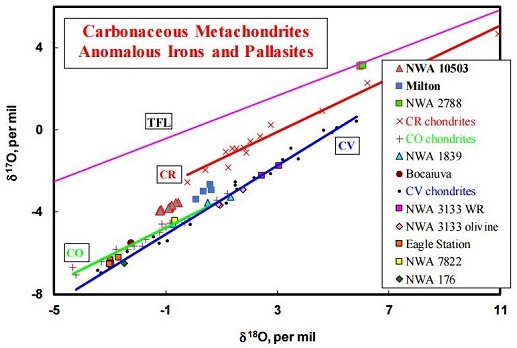
click on image for a magnified view
Diagram credit: Irving et al., 79th MetSoc, #6461 (2016)
Beyond that, new O-isotopic analyses conducted by Greenwood et al. (2014) on a large sampling of CM chondrites led them to suggest that a possible group relationship (same parent body) may exist between the CM and CO chondrites, previously considered to constitute a clan (groups formed at a similar heliocentricCentered around a sun. Our own Solar System is centered around the Sun so that all planets such as Earth orbit around the Sun. Note that 25% of Americans incorrectly believe the Sun revolves around the Earth. Click on Term to Read More distance) based on early research on refractory lithophile abundances, chondruleRoughly spherical aggregate of coarse crystals formed from the rapid cooling and solidification of a melt at ~1400 ° C. Large numbers of chondrules are found in all chondrites except for the CI group of carbonaceous chondrites. Chondrules are typically 0.5-2 mm in diameter and are usually composed of olivine Click on Term to Read More size and composition, and O-isotopic composition of high-temperature phases (Kallemeyn and Wasson, 1979, 1981). Moreover, it was found that the matrixFine grained primary and silicate-rich material in chondrites that surrounds chondrules, refractory inclusions (like CAIs), breccia clasts and other constituents. Click on Term to Read More component in meteorites of both groups have nearly identical minor element compositions (Greenwood et al., 2014, reference therein). Despite the hiatus that occurs between the CM and CO groups on an oxygen three-isotope diagram, their additional data clearly shows that the CM O-isotopic trend line intersects the CO field, and they have posited a new theory based on the premise that both groups formed on a common parent body. They suggest that the CO group could represent an inner anhydrous zone of a parent body larger than ~120 km in diameter, in which the initial accreted hydrous component was rapidly liberated through endogenous heating (radiogenic) and vented to the surface and into space (Fu and Elkins-Tanton, 2013). Conversely, the outer zone represented by the CM group experienced a high degree of aqueous alteration over an extended duration. A compatible scenario was presented by Fu and Elkins-Tanton (2013) in which early accretionAccumulation of smaller objects into progressively larger bodies in the solar nebula leading to the eventual formation of asteroids, planetesimals and planets. The earliest accretion of the smallest particles was due to Van der Waals and electromagnetic forces. Further accretion continued by relatively low-velocity collisions of smaller bodies in the Click on Term to Read More (within ~2 m.y. of CAI formation) of a planetesimal of significant size (>120 km in diameter), composed of low-density material akin to the CM chondrites, could experience internal differentiation without eruption of magmaMolten silicate (rock) beneath the surface of a planetary body or moon. When it reaches the surface, magma is called lava. Click on Term to Read More to the surface, thereby retaining a primitive hydrated crustal region.
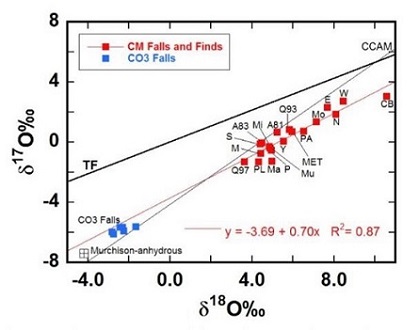
Diagram credit: Greenwood et al., 45th LPSC #2610 (2014)
A81:ALHA81002; A83:ALH 83100; CB:Cold Bokkeveld; E:Essebi; Ma:Maribo; MET:MET 01070; MI:Mighei; Mo:Moapa; M:Murchison; Mu:Murray; N:Nogoya; P:Paris (mean); PA:Paris-altered; PL:Paris-less altered; S:SCO06043; Q93:QUE93005; Q97:QUE97990; Y:Y791198; W:WIS91600; CO3 falls:Moss
Although terrestrial alteration in cold and hot deserts is a factor that needs to be considered, several CM-like meteorites were identified by Greenwood et al. (2019) which might be related and perhaps represent a separate CM-like parent body. These include EET 87522, GRO 95566, LEW 85311, MAC 87300, MAC 88107, NWA 5958, NWA 7821, NWA 11556 and Y-82054. On the other hand, a single large isotopically-heterogeneous CM parent body could be the source for all of these meteorites, and the variability in aqueous alteration that is observed among them may be attributed to differences in their water:rock ratio, temperature, and/or other factors.

click on image for a magnified view
In their comprehensive oxygen isotope study of carbonaceous chondriteCarbonaceous chondrites represent the most primitive rock samples of our solar system. This rare (less than 5% of all meteorite falls) class of meteorites are a time capsule from the earliest days in the formation of our solar system. They are divided into the following compositional groups that, other than Click on Term to Read More groups, Clayton and Mayeda (1999) showed that many ungroupedModifying term used to describe meteorites that are mineralogically and/or chemically unique and defy classification into the group or sub-group they most closely resemble. Some examples include Ungrouped Achondrite (achondrite-ung), Ungrouped Chondrite (chondrite-ung), Ungrouped Iron (iron-ung), and Ungrouped Carbonaceous (C-ung). Click on Term to Read More members plot along the same mixing line and fill the hiatus between the CO and CM fields (see diagram below). They suggest that both CO and CM groups consist of a common anhydrous silicate precursor, while the CM group represents the interaction of this anhydrous precursor with an aqueous reservoir. The ungrouped members are transitional, with variable water:rock ratios as indicated by the tick marks along the mixing line.
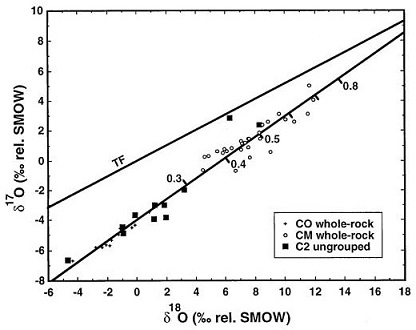
Diagram courtesy of Clayton and Mayeda, GCA, vol. 63, p. 2094 (1999)
‘Oxygen isotope studies of carbonaceous chondrites’
See also this oxygen three-isotope diagram presented by Jacquet et al., MAPS, vol. 51, #5, p. 862 (2016)
‘Northwest Africa 5958: A weakly altered CM-related ungrouped chondrite, not a CI3’ (http://dx.doi.org/10.1111/maps.12628)
Further evidence for a possible common CO–CM parent body was presented by Schrader and Davidson (2016; #1288). They analyzed the Cr content in olivine grain cores of type-II (FeO-rich) chondrulesRoughly spherical aggregate of coarse crystals formed from the rapid cooling and solidification of a melt at ~1400 ° C. Large numbers of chondrules are found in all chondrites except for the CI group of carbonaceous chondrites. Chondrules are typically 0.5-2 mm in diameter and are usually composed of olivine Click on Term to Read More for a number of CM chondrites spanning the full range of petrologic types (e.g., Sutter’s Mill [2.0/2.1]… QUE 97990 [2.6]). Utilizing a coupled diagram comparing the mean Cr2O3 content to the standard deviation (σ) of Cr2O3 content, they demonstrated that both the CO and CM thermal metamorphism curves overlap. Their study also shows that thermal metamorphism and aqueous alteration are not coupled. Another coupled diagram presented by Schrader and Davidson (2016) comparing the Fe and Mn contents of the type-II chondrules among the CM samples is also consistent with a common CO–CM parent body. Nevertheless, further studies by Schrader and Davidson (2017) led to the development of multiple lines of evidence which indicate that these two groups derive from separate parent bodies.
Moreover, a comparative analysis of CM and CO chondrites led Chaumard et al. (2018) to the conclusion that both of these groups formed in a common isotopic reservoir and accreted identical anhydrous precursor material comprised of the same two type-I chondrule populations: 1) Δ17O ~ –2.5–°, Mg# <96, and 2) Δ17O ~ –5–°, Mg# >98.5. Both CM and CO chondrites also accreted identical type-II chondrule populations. However, they recognized the many other characteristics that indicate a formation for these two groups on separate parent bodies, including differences in chondrule size (0.15 and 0.30 mm for CO and CM, respectively), matrix abundance (30–35 and 70 vol% for CO and CM, respectively), abundance of type-II chondrules that contain relict olivine grains (~48% and 12–25% for CO and CM, respectively), average CRE age (22 [ ±18] and 2.8 [ ±3.1] m.y. for CO and CM, respectively), accretion age (~2.1–2.7 and ~3.5–5.0 m.y. after CAIsSub-millimeter to centimeter-sized amorphous objects found typically in carbonaceous chondrites and ranging in color from white to greyish white and even light pink. CAIs have occasionally been found in ordinary chondrites, such as the L3.00 chondrite, NWA 8276 (Sara Russell, 2016). CAIs are also known as refractory inclusions since they Click on Term to Read More for CO and CM, respectively), and in abundance of hydrous phases (ice:rock ratio of ~0.1–0.2 and ~0.3–0.6 for CO and CM, respectively). They propose a scenario in which the snow line moved inward during the time interval between the accretion at nearly the same location (~2–3 AU) of these two distinct planetesimals.
Diagram credit: Chaumard et al., GCA, vol. 228, p. 220–242 (1 May 2018)
‘Oxygen isotope systematics of chondrules in the Murchison CM2 chondrite and implications for the CO-CM relationship’
(https://doi.org/10.1016/j.gca.2018.02.040)
A scenario compatible with the single parent body hypothesis was presented by Fu and Elkins-Tanton (2013). They propose that early accretion (within ~2 m.y. of CAI formation) of a planetesimal of significant size (>120 km in diameter) and composed of low-density material akin to the CM chondrites could experience internal differentiation without eruption of magma to the surface, thereby retaining a primitive hydrated crustal region. It could be deduced that a catastrophic disruption resulted in re-accretion of material into numerous daughter objects, which subsequently experienced impact-ejection of material into storage orbits within the outer asteroid beltBelt located between 2.12 and 3.3 AU from the Sun and located between the orbits of Mars and Jupiter containing the vast majority of asteroids. The asteroid belt is also termed the main asteroid belt or main belt to distinguish it from other asteroid populations in the Solar System such Click on Term to Read More. Further fragmentation events (collisional cascade processes), along with the Yarkovsky effect, would have delivered samples into mean motion resonances with some fragments eventually achieving Earth-crossing orbits.
The hypothesis of multiple daughter objects being formed following the catastrophic disruption of a large, partially differentiated primary planetary body could allow for the potential inclusionFragment of foreign (xeno-) material enclosed within the primary matrix of a rock or meteorite. Click on Term to Read More of several less closely-related meteorites. These may include the high-Ni irons of the South Byron trio (South Byron, ILD 83500, and Babb’s Mill), which have metallographic compositions (especially siderophile element patterns) and structures similar to the metal in Milton, including kamaciteMore common than taenite, both taenite and kamacite are Ni-Fe alloys found in iron meteorites. Kamacite, α-(Fe,Ni), contains 4-7.5 wt% Ni, and forms large body-centered cubic crystals that appear like broad bands or beam-like structures on the etched surface of a meteorite; its name is derived from the Greek word Click on Term to Read More spindles and associated schreibersiteNi-Fe phosphide mineral, (Fe,Ni)3P, yellowish in color and predominantly found in iron and stony-iron meteorites. Schreibersite can also be found in a variety of other meteorites including some acapulcoites, aubrites, enstatite chondrites and achondrites, lunars, ureilites, winonaites and a smattering of other meteorite types like CM, CO and CB. Schreibersite Click on Term to Read More, consistent with their formation on the same parent body (Reynolds et al., 2006). These three irons and the metal component in Milton experienced a similar oxidationOxidation and reduction together are called redox (reduction and oxidation) and generally characterized by the transfer of electrons between chemical species, like molecules, atoms or ions, where one species undergoes oxidation, a loss of electrons, while another species undergoes reduction, a gain of electrons. This transfer of electrons between reactants Click on Term to Read More history during formation; they each have similar depletions of easily oxidized elements as well as similar abundances of siderophiles (McCoy et al., 2008). In addition to the irons mentioned above, several other ungrouped ataxites may be genetically related to this high-Ni iron group, including El Qoseir, Illinois Gulch, Morradal, Nordheim, and Tucson (Kissin, 2010). However, significant differences that exist between their refractory element contents compared to those of the South Byron trio requires further work to establish a specific relationship.
The metal in each of these high-Ni iron meteorites and in Milton is consistent with early crystallization from a metallic-melt phase that experienced a low degree of fractionationConcentration or separation of one mineral, element, or isotope from an initially homogeneous system. Fractionation can occur as a mass-dependent or mass-independent process. Click on Term to Read More.
Further evidence for a large differentiated planetary body having CV-trends lies in the fact that CV chondrites acquired a strong unidirectional natural remanent magnetization ~8–10 m.y. after CAI formation, reflecting the existence of an internal core dynamo (e.g., Weiss et al., 2010; Elkins-Tanton et al., 2011; Carporzen et al., 2010, 2011; Gattacceca et al., 2013, 2016). Employing multiple investigation techniques, Shah et al. (2017) investigated the paleointensity of 19 Vigarano chondrules and found values of 1.1–150 µT. The observed magnetic remanence is considered to have been acquired during brecciationThe formation of a breccia through a process by which rock fragments of of various types are recemented or fused together. Click on Term to Read More events that occurred ~7 m.y. after initial parent body accretion, with impact shock pressures reaching 10–20 GPa. Therefore, they reason that the original paleofield would have been ~40 µT, which is too high to be attributable to the solar windSupersonic flow of high-speed charged particles continuously blowing off a star (mostly e- and p+). When originating from stars other than the Sun, it is sometimes called a "stellar" wind. The solar wind may be viewed as an extension of the corona into interplanetary space. The solar wind emanates radially field, but is in the range of that expected for a planetary core dynamo. As research continues, further evidence for the catastrophic disruption of this former primary body could advance this hypothesis.
Paleointensities Obtained for Allende
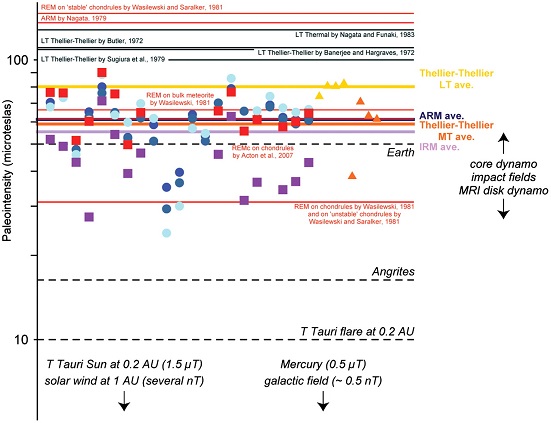
click on photo for a magnified view
Diagram credit: Carporzen et al., PNAS, vol. 108, #16 (2011, open access link)
‘Magnetic Evidence for a Partially Differentiated Carbonaceous Chondrite Parent Body’
(https://doi.org/10.1073/pnas.1017165108)







